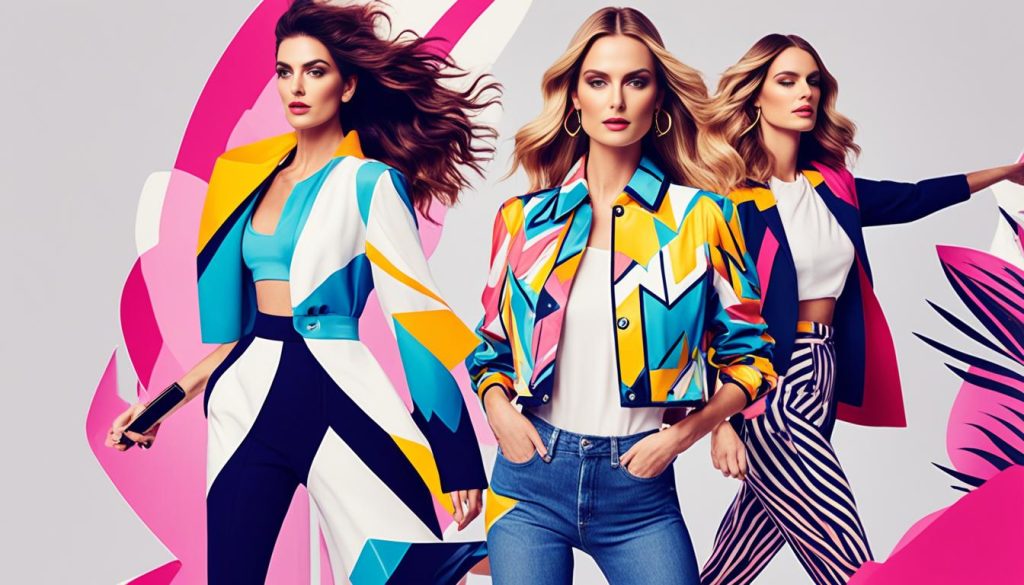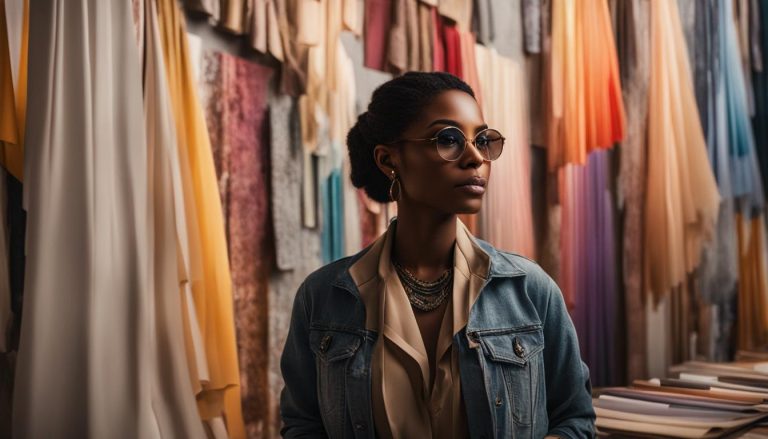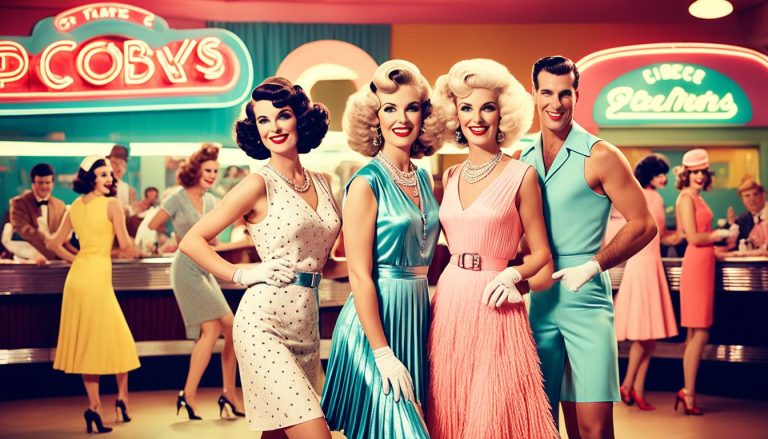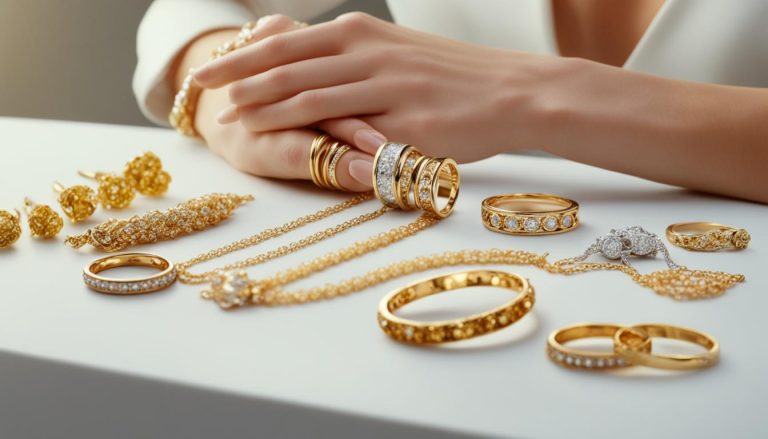Welcome to the world of fashion marketing, where creativity, style, and strategy collide. Whether you’re a fashion enthusiast, aspiring designer, or business-minded individual, understanding the dynamics of fashion marketing is essential to succeed in the industry. In this article, we will dive deep into what fashion marketing is all about and how you can define your own unique style in this competitive landscape.
Key Takeaways:
- Fashion marketing involves promoting and selling fashion products to consumers.
- It focuses on creating brand awareness, driving sales, and staying on top of the latest fashion trends.
- Fashion marketing differs from traditional marketing by emphasizing aesthetics, creativity, and cultural sensitivity.
- Current fashion marketing trends include influencer collaborations and sustainable fashion initiatives.
- Fashion marketing offers various career opportunities, such as fashion marketing manager and social media manager.
The Importance of Fashion Marketing
Fashion marketing is not just about showcasing beautiful clothing and accessories; it is a strategic process that plays a vital role in the success and growth of fashion brands. By implementing effective marketing strategies, fashion brands can position themselves in the market, attract their target audience, and build a loyal customer base.
Here are some key reasons that highlight the significance of fashion marketing:
- Creating Brand Awareness: Fashion marketing helps to establish brand recognition and visibility in the highly competitive fashion industry. With the right marketing strategies, brands can reach a wider audience and make a lasting impression.
- Attracting Customers: By understanding consumer behavior and preferences, fashion marketing can attract and engage potential customers. It involves creating compelling messaging and visual content that resonates with the target audience, sparking their interest and desire to purchase.
- Generating Sales: Effective fashion marketing strategies are designed to drive sales and increase revenue. By implementing tactics such as promotional campaigns, collaborations, and exclusive offers, fashion brands can entice customers to make a purchase and increase their bottom line.
- Differentiating from Competitors: The fashion industry is saturated with numerous brands competing for consumer attention. Fashion marketing strategies help brands stand out by highlighting their unique value proposition, unique designs, and brand aesthetics. It enables brands to differentiate themselves from competitors and carve a distinct identity in the market.
- Staying on Top of Fashion Trends: Fashion is an ever-changing industry, and staying updated with the latest trends is critical. Fashion marketers continually analyze market trends, consumer preferences, and cultural influences to ensure that the brand’s collections are relevant and appealing to their target audience.
With these compelling reasons, it is evident that fashion marketing is an integral part of the fashion business. It empowers brands to build a strong presence, connect with their customers, and drive successful outcomes.
“Fashion marketing is not just about selling clothes; it’s about selling emotions, aspirations, and creating an experience that resonates with the audience.”
| Fashion Marketing Strategies | Benefits |
|---|---|
| 1. Influencer Collaborations | – Expands brand reach – Builds trust and credibility – Drives sales through influencer recommendations |
| 2. Social Media Marketing | – Engages with target audience – Showcases brand image and values – Encourages user-generated content |
| 3. Content Marketing | – Positions the brand as an industry expert – Educates and entertains the audience – Drives organic traffic and brand awareness |
| 4. Experiential Marketing | – Creates memorable brand experiences – Generates buzz and word-of-mouth – Fosters emotional connections with customers |
| 5. Data-driven Marketing | – Provides actionable insights for targeted marketing – Improves customer segmentation and personalization – Optimizes marketing budgets and ROI |
Implementing a combination of these strategies can help fashion brands maximize their marketing efforts and achieve their business goals.
Fashion Marketing vs. Traditional Marketing
Fashion marketing and traditional marketing may seem similar on the surface, but they differ significantly in their approach and goals. Where traditional marketing focuses on functionality and broad appeal, fashion marketing emphasizes aesthetics, creativity, and cultural sensitivity. Understanding these distinctions is crucial for fashion brands to effectively connect with their target audience and stand out in the competitive market.
In traditional marketing, the primary objective is to promote a product or service based on its features, benefits, and value proposition. This approach relies heavily on market research, consumer behavior analysis, and strategic advertising campaigns. While effective in many industries, traditional marketing may not fully capture the unique essence of fashion brands.
“Fashion marketing emphasizes aesthetics, creativity, and cultural sensitivity.”
Fashion marketing recognizes that fashion is more than just clothing – it is an expression of identity, style, and cultural values. It goes beyond functionality and taps into the emotional connection individuals have with fashion. This form of marketing aims to evoke desire, aspiration, and a sense of belonging within the target audience.
Visual appeal plays a central role in fashion marketing. It utilizes captivating imagery, fashion photography, and visually stunning campaigns to engage and entice consumers. Whether it’s a striking image in a magazine, a viral social media post, or a captivating runway show, fashion marketing leverages the power of aesthetics to create an emotional response and leave a lasting impression.
Creative storytelling is another distinguishing feature of fashion marketing. Brands often weave narratives around their products, incorporating elements of art, culture, and history. By telling stories, fashion marketing enhances the overall brand experience and establishes a deeper connection with consumers.
Furthermore, fashion marketing is highly attuned to cultural trends and influences. Fashion brands continually adapt to changing consumer preferences, societal shifts, and emerging fashion movements. This level of cultural sensitivity ensures that fashion brands remain relevant and authentic, resonating with their target audience.
The Key Differences at a Glance
| Fashion Marketing | Traditional Marketing |
|---|---|
| Emphasizes aesthetics and design | Prioritizes functionality and features |
| Focuses on visual appeal and creativity | Relies on market research and consumer behavior analysis |
| Incorporates cultural trends and influences | Targets a broader audience |
| Utilizes storytelling techniques | Relies on strategic advertising campaigns |
By understanding the unique qualities that differentiate fashion marketing from traditional marketing, fashion brands can develop strategies that effectively communicate their brand identity, engage their target audience, and drive sales. The combination of visual appeal, creativity, and cultural sensitivity sets fashion marketing apart in an industry where style and individual expression reign supreme.
In the next section, we will explore the latest trends in fashion marketing and how they are shaping the industry. Stay tuned!
Fashion Marketing Trends
In the fast-paced world of fashion, it’s crucial for fashion marketers to stay ahead of the game and keep up with the latest trends. By embracing these trends, you can elevate your brand’s marketing strategies and effectively connect with your target audience. Here are some of the current fashion marketing trends that you should be aware of:
Influencer Collaborations
One of the most powerful marketing strategies in the fashion industry is collaborating with influencers. These individuals have a strong online presence and a loyal following, making them an ideal channel for brand promotion. By partnering with influencers who align with your brand values and aesthetics, you can tap into their engaged audience and increase brand awareness.
Sustainable Fashion Initiatives
The rise of sustainable fashion is a trend that cannot be ignored. Consumers are becoming increasingly conscious of the environmental impact of the fashion industry and are seeking out sustainable brands. By incorporating sustainable practices into your marketing efforts, such as promoting eco-friendly materials or highlighting ethical production processes, you can attract eco-conscious consumers and differentiate your brand in the market.
Experiential Marketing
In today’s digital age, experiential marketing provides a unique and immersive way to engage with consumers. By creating memorable experiences that allow customers to interact with your brand, either through events, pop-up stores, or interactive online campaigns, you can build a deeper connection and foster brand loyalty. These experiences leave a lasting impression that goes beyond just a transactional relationship.
Social Media Platforms
Social media platforms continue to play a significant role in fashion marketing. With their visually oriented nature, platforms like Instagram, TikTok, and Pinterest provide the perfect space to showcase your brand’s aesthetic and reach a wide audience. By leveraging these platforms effectively, you can engage with your target market, drive traffic to your website, increase conversions, and amplify brand visibility.
Staying updated with these fashion marketing trends is essential for brands that want to remain relevant and appeal to their target market. Whether it’s collaborating with influencers, adopting sustainable practices, embracing experiential marketing, or leveraging social media, these trends offer valuable opportunities to elevate your brand and connect with your audience in meaningful ways.
Stay ahead of the competition by embracing these fashion marketing trends, and your brand will be well-positioned for success in the ever-evolving fashion industry.
Fashion Marketing Careers
If you have a passion for fashion and a knack for marketing, a career in fashion marketing could be the perfect fit for you. Fashion marketing offers a wide range of exciting career opportunities where you can combine your creativity and business acumen to make a mark in the fashion industry. Below are some common fashion marketing roles that can pave the way to a successful and fulfilling career:
Fashion Marketing Manager
A fashion marketing manager is responsible for developing and implementing marketing strategies to promote a fashion brand. They oversee advertising campaigns, analyze market trends, and collaborate with designers and teams to ensure the brand’s message reaches the target audience effectively.
Brand Manager
A brand manager plays a critical role in shaping a fashion brand’s identity. They develop brand strategies, manage brand positioning, and ensure consistency across all marketing channels. Brand managers also conduct market research to understand consumer behavior and make informed decisions to drive brand growth.
Social Media Manager
In today’s digital world, social media plays a crucial role in fashion marketing. A social media manager handles the brand’s social media presence, creating engaging content, managing social media campaigns, and interacting with followers. They have a finger on the pulse of social media trends and use data analytics to optimize social media strategies.
Fashion Publicist
A fashion publicist is responsible for building and maintaining relationships with the media and influencers. They pitch stories, organize press events, and secure media coverage for fashion brands. Fashion publicists act as the brand’s spokesperson and work closely with journalists and stylists to increase brand visibility.
Fashion Trend Analyst
As a fashion trend analyst, you would stay ahead of the curve by spotting emerging fashion trends and translating them into marketing strategies. Fashion trend analysts conduct market research, analyze fashion shows, and keep an eye on street style to forecast trends that will resonate with the target audience.
These roles offer exciting challenges and opportunities for growth in the dynamic world of fashion marketing.
| Role | Responsibilities |
|---|---|
| Fashion Marketing Manager | Develop and implement marketing strategies, oversee advertising campaigns, analyze market trends |
| Brand Manager | Develop brand strategies, manage brand positioning, conduct market research |
| Social Media Manager | Create engaging content, manage social media campaigns, analyze social media trends |
| Fashion Publicist | Build and maintain relationships with the media, organize press events, secure media coverage |
| Fashion Trend Analyst | Spot emerging fashion trends, translate trends into marketing strategies, conduct market research |
Whether you aspire to be a fashion marketing manager, brand manager, social media manager, fashion publicist, or fashion trend analyst, the fashion industry offers a wealth of opportunities to unleash your creativity and shape the future of fashion. By combining your passion for fashion with your marketing skills, you can carve a successful career path in this exciting field.
Fashion Marketing Agencies
Fashion marketing agencies are invaluable partners for fashion brands, offering specialized services to enhance their marketing efforts and reach a wider audience. These agencies bring expertise in various areas, such as:
- Market research
- Branding
- Digital marketing
- Public relations
- Event management
By working with fashion marketing agencies, brands can tap into their knowledge and experience to create effective marketing strategies tailored to their target audience. These agencies understand the fashion industry and stay up-to-date with the latest trends and consumer preferences. They help brands navigate the complex landscape of fashion marketing, ensuring that their message resonates and drives engagement.
One of the key advantages of working with fashion marketing agencies is their ability to conduct in-depth market research. They utilize a range of techniques to analyze market trends, consumer behavior, and competitor strategies. This research provides valuable insights that inform branding decisions and marketing campaigns, helping fashion brands gain a competitive edge.
Furthermore, fashion marketing agencies excel in creating compelling brand identities. They work closely with brands to develop unique and cohesive visual identities, including logos, color palettes, typography, and imagery. These elements are crucial in establishing a strong brand presence and conveying the brand’s personality and values to the target audience.
Additionally, fashion marketing agencies are adept at leveraging digital platforms to expand brand reach. With expertise in digital marketing and social media management, these agencies help brands navigate the ever-evolving landscape of online marketing. From creating engaging content to implementing targeted ad campaigns, fashion marketing agencies employ strategies to enhance brand visibility and drive online sales.
“Working with fashion marketing agencies allows brands to tap into their industry knowledge and experience. These agencies bring a fresh perspective and specialized skills that can elevate a fashion brand’s marketing efforts.”
To illustrate the impact of fashion marketing agencies, consider the example of Luxe Fashion. By partnering with a renowned agency, Luxe Fashion was able to leverage market research and create a compelling brand identity that resonated with its target audience. The agency’s expertise in digital marketing helped Luxe Fashion expand its online presence, resulting in increased brand awareness and sales.
| Benefits of Fashion Marketing Agencies | Examples |
|---|---|
|
|
Fashion Marketing Examples
When it comes to fashion marketing, there is no shortage of innovative and successful campaigns that have captured the attention of consumers. Let’s take a look at a few standout examples that highlight the creativity and effectiveness of fashion marketing strategies.
Gucci’s Collaborations with Artists and Influencers
Gucci is known for its bold and eclectic approach to fashion marketing. One strategy that has been particularly successful for the brand is its collaborations with popular artists and influencers. By partnering with individuals who resonate with their target audience, Gucci has been able to tap into new markets and create a buzz around their brand. This approach not only increases brand visibility but also adds an element of exclusivity and desirability to their products.

Nike’s Inclusive Advertising Campaigns
Nike has long been at the forefront of inclusive marketing in the fashion industry. Through their advertising campaigns, they celebrate diversity and promote inclusivity. Whether it’s featuring athletes of different backgrounds or highlighting stories of empowerment, Nike’s marketing efforts resonate with a wide range of consumers. This approach not only aligns with their brand values but also helps them connect with their target audience on a deeper level.
Chanel’s Storytelling in Marketing
Chanel is a brand that understands the power of storytelling in marketing. They have mastered the art of creating narratives around their products, weaving stories that evoke emotion and establish a connection with their audience. Through their marketing campaigns, Chanel transports consumers into a world of luxury, elegance, and sophistication. By tapping into the aspirational desires of their target market, they effectively showcase their brand identity and create a sense of desire for their products.
“The most successful fashion marketing campaigns are those that go beyond just selling products. They create meaningful connections, tell stories, and inspire emotions.” – Fashion Marketing Expert
These examples demonstrate the effectiveness of fashion marketing strategies that go beyond traditional advertising. By collaborating with artists and influencers, promoting inclusivity, and utilizing storytelling techniques, fashion brands can captivate their audience and create long-lasting brand loyalty.
Define Your Niche and Unique Selling Proposition (USP)
Before starting a fashion brand, you need to define your niche and unique selling proposition (USP). This crucial step involves identifying the gap in the fashion marketing niche that your brand aims to fill and determining what sets it apart from competitors. By defining your niche and USP, you establish your brand’s identity and attract your target audience.
Identifying Your Niche
When defining your fashion marketing niche, consider factors such as:
- Target market demographics
- Style preferences
- Price points
- Geographic location
By narrowing down your target audience, you can create a more focused marketing strategy and tailor your products and messaging accordingly.
Determining Your Unique Selling Proposition
Your unique selling proposition is what sets your fashion brand apart from competitors and makes it irresistible to your target audience. Consider the following questions to establish your USP:
- What makes your products unique or different?
- Do you offer superior quality?
- Are you known for ethical or sustainable practices?
- Do you provide exceptional customer service?
- Is there a specific fashion trend or style that you excel in?
Once you have identified your USP, weave it into your brand messaging and make it a central focus of your marketing efforts.
“The fashion marketing niche gives your brand a specific audience to target, while your USP differentiates your brand from competitors.”
Having a well-defined niche and USP not only helps you stand out in a competitive market but also attracts loyal customers who resonate with your brand values and uniqueness.
Keep in mind that as trends evolve and consumer preferences change, it may be necessary to re-evaluate and refine your niche and USP to stay relevant in the fashion industry.
Conduct Market Research
To succeed in the ever-evolving fashion industry, it is crucial to have a deep understanding of the market and its trends. Conducting comprehensive fashion market research allows you to gain insights into consumer preferences, analyze competitors, and identify potential collaborations. By leveraging the power of market research, you can make informed decisions about your design choices, pricing strategy, and overall marketing efforts.
Understanding Consumer Preferences
Market research helps you understand the desires, needs, and preferences of your target audience. Through surveys, focus groups, and analysis of consumer behavior, you can gather valuable insights that shape your fashion brand’s offerings. This knowledge enables you to create products that resonate with your customers, increasing the likelihood of sales and long-term brand loyalty.
Analyzing Competitors
Studying your competitors is crucial for staying ahead in the highly competitive fashion industry. By analyzing the strategies, strengths, and weaknesses of other brands, you can identify gaps in the market and differentiate your fashion brand. This analysis helps you position your brand effectively, highlighting its unique selling points and building a competitive edge.
Identifying Potential Collaborations
Market research also allows you to identify potential collaborators within the fashion industry. By studying the market landscape, you can uncover opportunities for partnerships with complementary brands, influencers, or manufacturers. Collaborations can amplify brand visibility, attract new customers, and enhance your fashion brand’s overall reputation.
Through thorough fashion market research, you can anticipate shifts in consumer preferences, detect emerging trends, and make data-driven decisions. This knowledge helps guide your design choices, pricing strategy, and overall marketing efforts, ensuring that your fashion brand stays relevant and profitable.
| Benefits of Market Research | Importance |
|---|---|
| Identifies consumer preferences | Informs design choices |
| Provides insights into market trends | Guides pricing strategy |
| Analyzes competitor strategies | Identifies collaborations |
Create a Business Plan
A well-defined business plan is crucial for the success of your fashion brand. It serves as a roadmap, outlining your brand’s mission, vision, and goals. A comprehensive business plan allows you to articulate your target market, develop an effective marketing strategy, create financial projections, and establish operational plans.
Your business plan should clearly communicate your fashion brand’s mission and what sets it apart from competitors. It’s an opportunity to showcase your unique selling proposition and highlight the value your brand brings to the market.
Additionally, a thorough business plan helps attract investors or partners who share your vision and see the potential for growth in your fashion brand. It demonstrates your commitment to strategic planning and your ability to execute your ideas.
“A business plan is the foundation upon which successful businesses are built. It provides clarity, direction, and a framework for decision-making.”
– Sarah Johnson, Fashion Business Consultant
When creating your business plan, consider the following key components:
- Brand Mission and Vision: Clearly define your brand’s purpose and long-term vision.
- Target Market Analysis: Identify your ideal customers and understand their needs, preferences, and buying behaviors.
- Competitive Analysis: Research your competitors to identify their strengths, weaknesses, and market positioning.
- Marketing Strategy: Develop a comprehensive plan to reach and engage your target audience through various marketing channels.
- Financial Projections: Create realistic financial forecasts, including sales projections, expenses, and profitability.
- Operational Plans: Outline your manufacturing, sourcing, distribution, and inventory management strategies.
Remember, your business plan should be a living document that evolves as your fashion brand grows and adapts to the changing market landscape. Regularly review and update your plan to ensure it remains aligned with your brand’s mission and goals.
By creating a well-thought-out business plan, you are setting yourself up for success. It provides a clear roadmap for your fashion brand, guides your decision-making process, and communicates your vision to potential investors and partners.
Design Your Brand Identity
In the fashion industry, creating a strong and cohesive brand identity is essential for success. It goes beyond just having a logo; it encompasses brand colors, typography, imagery, and the overall aesthetic that sets your fashion brand apart. A well-crafted brand identity helps build recognition, establish trust, and lay the foundation for a strong and enduring brand.
When designing your fashion brand’s identity, consider the following key elements:
1. Logo
Your logo is the visual representation of your brand. It should be unique, memorable, and reflective of your brand’s values and personality. Opt for a design that resonates with your target audience and effectively communicates your brand’s aesthetic and identity.
2. Brand Colors
Choose a color palette that aligns with your brand’s personality and resonates with your target customers. Colors evoke emotions and can create a lasting impression. Consider the psychology of colors and the message you want to convey through your brand.
3. Typography
The choice of fonts and typography plays a significant role in establishing your brand’s identity. Select fonts that reflect the overall aesthetic of your fashion brand and are legible across different platforms and mediums.
4. Imagery
The imagery you use, whether in your marketing materials, website, or social media, should be consistent with your brand’s identity. Use high-quality visuals that align with your brand aesthetic and evoke the desired emotions in your audience.
5. Overall Aesthetic
Consider the overall aesthetic you want to convey through your brand. This encompasses the combination of colors, fonts, imagery, and design elements that come together to create a cohesive and visually appealing brand image.
By carefully crafting and maintaining a consistent brand identity, you can effectively differentiate your fashion brand from competitors, attract your target audience, and build long-lasting relationships with customers.

Expert Tip:
“Your brand identity should align with your target audience’s preferences and aspirations. Continuously monitor market trends and consumer behavior to ensure your brand remains relevant and resonates with your customers.”
Source Quality Materials and Manufacturers
To maintain the integrity of your fashion brand, it is crucial to source high-quality materials and work with reputable manufacturers. By building strong relationships with suppliers who prioritize quality, you can ensure that your products meet the standards your customers expect.
When selecting materials, consider factors such as durability, comfort, and aesthetic appeal. Opt for sustainable and ethically sourced materials whenever possible, as consumers are increasingly conscious of the environmental and social impact of the fashion industry.
Similarly, partnering with manufacturers who share your commitment to quality is essential. Look for manufacturers who have a proven track record of producing well-crafted garments and accessories. Remember to consider their expertise in working with specific materials and their ability to deliver consistent results.
By sourcing quality materials and working with reliable manufacturers, you can provide your customers with fashion products that not only look great but also stand the test of time. This commitment to quality will not only enhance your brand’s reputation but also contribute to customer loyalty and satisfaction.
Determining Material Quality
When assessing the quality of materials, there are several factors to consider:
- Texture and Feel: Choose materials that are soft, smooth, and comfortable against the skin. Consider how the material will behave over time, ensuring it retains its shape and resists pilling or fading.
- Durability: Select materials that can withstand regular wear and tear without losing their quality. Evaluate the material’s strength, resistance to stretching or tearing, and ability to hold up through repeated washing and use.
- Sustainability: Prioritize materials that are environmentally friendly and have a reduced impact on the planet. Look for certifications or labels indicating sustainable practices, such as organic or recycled materials.
Choosing Reliable Manufacturers
When searching for manufacturers to partner with, consider the following criteria:
- Experience and Expertise: Look for manufacturers with a proven track record in producing high-quality fashion products. Consider their experience in working with similar materials and designs, ensuring they have the expertise needed to bring your vision to life.
- Quality Control: Inquire about the manufacturer’s quality control processes to ensure consistent product standards. Ask about their inspection procedures and how they address any issues or defects that may arise during production.
- Ethical Practices: Ensure that the manufacturer aligns with your brand’s ethical values. Inquire about their labor practices, compliance with fair trade standards, and commitment to worker safety and well-being.
Factors to Consider in Material and Manufacturer Selection
| Factors | Material Selection | Manufacturer Selection |
|---|---|---|
| Quality | Consider durability, comfort, and aesthetic appeal | Assess experience, expertise, and adherence to quality control processes |
| Sustainability | Opt for sustainable and ethically sourced materials | Evaluate environmental practices and commitment to ethical standards |
| Texture and Feel | Choose soft, smooth, and comfortable materials | N/A |
| Durability | Select materials that withstand wear and tear | N/A |
| Experience | N/A | Consider past experience and track record in the industry |
| Expertise | N/A | Evaluate proficiency in working with specific materials and designs |
| Quality Control | N/A | Ensure robust quality control processes |
| Ethical Practices | N/A | Inquire about labor practices and commitment to ethical standards |
Implement Effective Marketing Strategies
Implementing effective marketing strategies is crucial for the success of your fashion brand. By utilizing a mix of digital marketing, influencer collaborations, traditional PR, and search engine optimization (SEO), you can reach a broader audience and increase brand visibility.
Digital marketing: In today’s digital age, having a strong online presence is essential. Utilize social media platforms, email marketing, and content creation to engage with your target audience and showcase your fashion products. Implementing SEO techniques will boost your brand’s visibility in search engine results, driving organic traffic to your website.
Influencer collaborations: Partnering with influencers can significantly amplify your brand’s reach and influence. Identify influencers who align with your brand’s values and aesthetics and collaborate on sponsored content, product reviews, or brand campaigns. Their trusted endorsements can help attract new customers and build credibility for your fashion brand.
“Influencer collaborations can significantly amplify your brand’s reach and influence.”
Traditional PR: While digital marketing is essential, traditional public relations (PR) strategies should not be overlooked. Building relationships with fashion journalists, stylists, and media outlets can help secure press coverage and increase brand awareness. Engage in fashion events, runway shows, and fashion weeks to showcase your brand to industry insiders and potential customers.
SEO
| Benefits of SEO for Fashion Brands | How to Implement SEO for Fashion Brands |
|---|---|
| 1. Increased visibility and organic traffic to your website | 1. Conduct keyword research to identify relevant keywords for your fashion brand |
| 2. Higher search engine rankings | 2. Optimize website content, meta tags, and descriptions with target keywords |
| 3. Improved brand credibility and trust | 3. Build high-quality backlinks from reputable fashion websites |
| 4. Cost-effective long-term digital marketing strategy | 4. Create original, high-quality content that resonates with your target audience |
Customer feedback and data analysis: Constantly analyze sales data, customer feedback, and market trends to make informed marketing decisions. Monitor website analytics, social media insights, and customer reviews to gain insights into your target audience’s preferences and behavior. This data will help you adapt your marketing strategies and product offerings to better serve your customers’ needs.
By implementing these fashion marketing strategies, you can effectively promote your fashion brand and drive sales. Stay updated with the latest industry trends and continuously refine your marketing efforts to stay ahead in the competitive fashion market.
Conclusion
Fashion marketing is a dynamic and ever-evolving field that plays a pivotal role in the success of fashion brands. By defining a niche, conducting market research, creating a strong brand identity, and implementing effective marketing strategies, fashion brands can stand out in a competitive industry. Staying innovative and attuned to market trends are key to thriving in the world of fashion marketing.
Defining a niche is essential for fashion brands to establish their unique selling proposition (USP) and target their ideal audience. Through comprehensive market research, brands gain valuable insights into consumer preferences, market trends, and potential collaborators, enabling them to make informed strategic decisions.
A strong brand identity is crucial in the fashion industry, as it creates recognition and builds trust among consumers. Consistency in branding, encompassing visual elements, such as colors, typography, and imagery, contributes to the overall aesthetic and communicates the essence of the brand.
Implementing effective marketing strategies, encompassing a mix of digital marketing, influencer collaborations, traditional PR, and SEO, is essential to reach a broader audience. Keeping a pulse on market trends, analyzing sales data, customer feedback, and staying agile ensures that fashion brands are responsive to changes in the industry.









+ There are no comments
Add yours